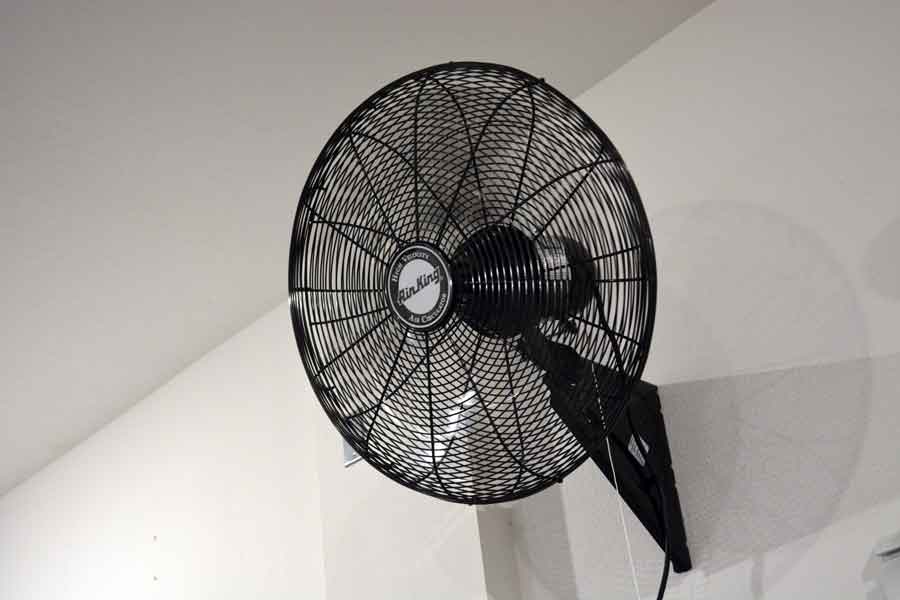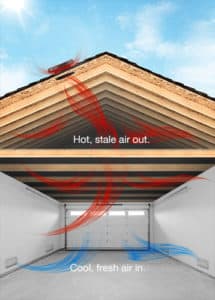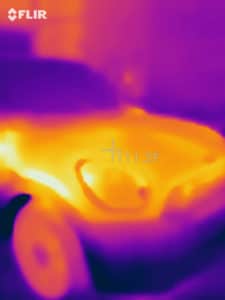My first summer as a homeowner in Florida was brutal. After a few weeks of 90-degree heat and 90% humidity, I wondered how to keep a garage cool in these extreme temperatures.
I found a few things that helped, and over the next few years, I added a couple more until I came up with this list. Hopefully, it’ll save you some time and give you a few ideas you might not have thought about.
How do you keep your garage cool in the summer? The best way is to create air circulation with ceiling fans and garage vents in the ceiling or exterior walls. Some prefer air conditioning, but it’s usually considerably more expensive. Of course, don’t overlook insulating the walls and garage door and ensuring your weatherstripping is doing its job.
Here are some of the best ideas I’ve found to help keep your garage cool, including some commentary on each.
Garage Fans
Installing a fan in your garage will make you feel the most significant impact. They’re also some of the cheapest options on this list, except for some free tips I’ll get to later.
Garage fans come in two major types: ceiling fans or wall-mountable\floor-standing fans.
Ceiling fans will mount to the ceiling, just like they would inside your home. They always face down from the top and will have the best circulation directly underneath. If you’ve got a larger garage, you’ll need larger blade lengths (60″ or above) or even multiple smaller ceiling fans.
Wall mountable or floor-standing fans will direct the air horizontally across the garage. They’re most effective when blowing the air out the door or to an exterior garage vent. The concept is the same whether you mount the fan on the wall or have a free-standing fan.

Instead, opt for a fan with metal blades instead of wood or plastic fan blades. Metal blades usually are lighter and easier to clean.
Also, be sure that the fan you’re looking at has a sealed motor housing. Your garage can be messy, which will help keep out sawdust and other flying particles.
Bonus: Flying insects don’t like fast-moving air. This is also a great way to get those flying buggers out of your hair.
I wrote a detailed article on what I consider the best garage fan, explaining why I switched from a Lasko Stanley fan to an Air King wall-mounted fan.
Check it out for more great information!
Dehumidifier
You know that old saying: it’s not the heat, it’s the humidity?
One of the best things I did to make my garage more bearable in the summer was to use a dehumidifier.
This isn’t as useful if you live in the Southwest, where temperatures can hit 120 degrees but with no humidity. A dehumidifier should be on your list for the rest of the country.
One of the key features is a drain hose connection for a maintenance-free operation. This lets you hook up a regular garden hose to the dehumidifier to allow the water to drain out on its own.
For less than $200, you can get a heavy-duty, 70-pint dehumidifier that covers 2,000 square feet of your home. You may not need that much, but it’s better to (slightly) over-buy than to over-work the unit.
If you want more information on the humidifier I use in my garage, check out my full review here. It’s also got some great tips on what size dehumidifier you should get, regardless of your garage size.
Insulation (Door and Ceiling)
There are three significant areas where you need insulation in your garage. Most garages are missing all three of them.
Insulating your garage ceiling is critical if you have living space above your garage.
My master bedroom sits directly over the garage. You can definitely feel it in the summer. The heat from the garage radiates through the floor, and my air conditioner has to work overtime to keep the house cool.
The next item on the list depends on your construction.
If the outside of your house is aluminum siding, wood, or stucco, you’ll want to insulate and drywall your garage walls. This will help seal any air leaks and keep the cool air in and the hot air outside where it belongs.
If your garage is made with cinder-block walls, like mine, I recommend insulating your garage door. I’ve covered that in another article.
Remember that your garage door is the single biggest opening in your home.
You wouldn’t dream of having leaky windows, so why have a leaky garage door?
Weatherstripping
One of the minor tweaks on my list is to fix the weather stripping around my garage.
Simply sealing up the air gaps around your garage door, windows, and even the door to the house will go a long way to keeping your garage cooler.

Garage Vents
If you’re working on your car in the garage, you need to have a garage vent. Period.

Combined with a fan, a garage vent will help keep the air moving so it doesn’t feel as hot. More importantly, you won’t inhale any toxic fumes from your engine.
The most common garage vent is a simple turbine fan on your roof to vent the warm air straight up and out.
I’d need to have a vent on one of the walls since there’s a bedroom directly above the garage in my house.
Keep the vent as possible so the warmer air gets blown out.
You can also find vents that are cut directly into your garage door.
You should get good air circulation and cool things down if used with garage fans.
Air Conditioning
Undoubtedly, air conditioning will do the best job of keeping your garage cool.
It’s also by far the most expensive.
Air conditioners are typically expensive to purchase or are so inefficient that they’re expensive over their entire lifespan.
Cutting a hole in the wall to install an air conditioner will add potential leaks to your home. That nullifies the effect of that insulation you installed earlier.
This will end up costing you more in the long run.
Unless you’ve gone through the steps of insulating your garage and sealing the leaks, you’re spending far more on electricity than you should be.
Speaking of whole-house air conditioners, you could add some additional ducting in your garage ceiling, right?
Well, yes, but it’s not a great idea.
Matt Risinger, a builder with a great YouTube channel, recommends against it.
You’ll be overworking your air conditioner unit.
More importantly, you’ll also create a negative pressure zone in your house as it tries to replace the air you’re pumping into the garage. It will get that air from other places, some of which could release toxic fumes into your home.
I recommend only buying an air conditioner for your garage as a last step. Trust me. Do the prep work first.
Add More Shade Outside
Stay with me now because I’m going to say something crazy:
The more the sun hits your garage, the hotter it will get.
Science.
But in all seriousness, one of the cheapest ways to cool your garage is by keeping it in the shade.
Obviously, this is a slower solution. There may also be issues if you live in a community with a homeowner’s association (HOA).

Think about adding a shade tree, a climbing vine-like ivy on the walls, or even an awning over your garage door.
Outside my garage, which you can see above, I’ve started a bougainvillea bush growing up a homemade trellis on each side. It’s only about a year old, but it’s already growing nicely and is shading the concrete and stucco wall behind it.
Once they get taller, two large maple trees will provide shade on both the walls and the garage door.
Let Your Car Cool Down First
I needed to see this to believe it.
This is a thermal image of my car taken with my Flir camera. It’s been sitting in my garage for almost two hours after I got home.

That bright yellow spot is residual heat from my engine, acting as a giant garage space heater.
Your car is a big metal box, and all those metal surfaces store heat well. When you pull your car into your garage, your car will start transferring that heat into the surrounding air.
Here’s a little test if you don’t believe me and don’t have access to a thermal camera.
The next time you’ve driven your car home from work, park it inside with the garage door closed and the lights off. Wait about 30 minutes and put your hand on the car’s hood.
You’ll still be able to feel the engine’s heat long after you’ve come home.
My challenge is finding ways to keep my garage cool despite my car being there. The whole point of transforming my garage is to give my car a better home, so ensuring all these other things are in place is essential.
This is why it’s crucial to find ways to keep your car cool in summer before you park it in your garage.
How to Keep a Garage Cool in Summer: Wrapping It Up
I’m not gonna lie. The blistering heat of a Florida summer can be rough. But, over the years, I’ve picked up a few tips on how to keep a garage cool (or as cool as it can be) in the Florida heat.
We’ve explored optimizing ventilation, leveraging insulation, and utilizing fans and AC units. It’s not just about keeping ourselves comfortable but protecting our belongings from the harsh heat as well.
If there’s one thing to take away from our adventure, it’s that maintaining a cooler garage is achievable. It’s not rocket science, just a bit of Florida man know-how mixed with practical solutions.
